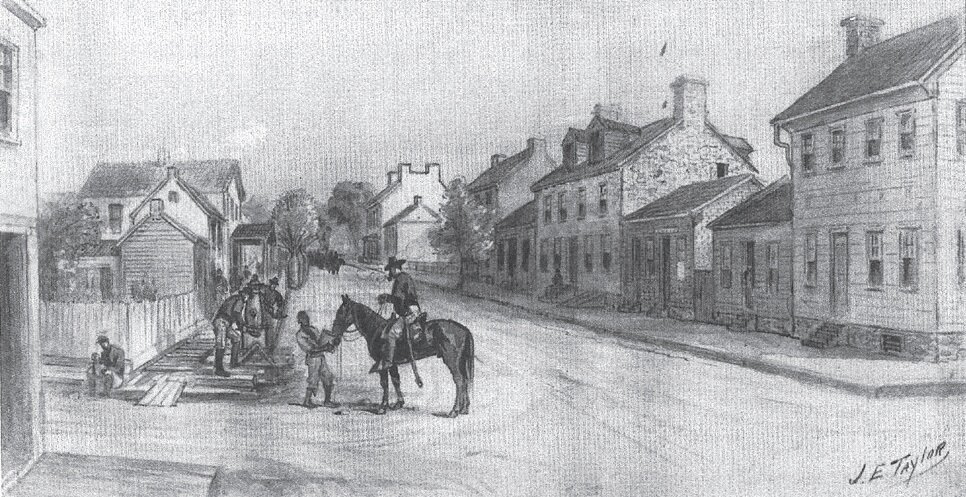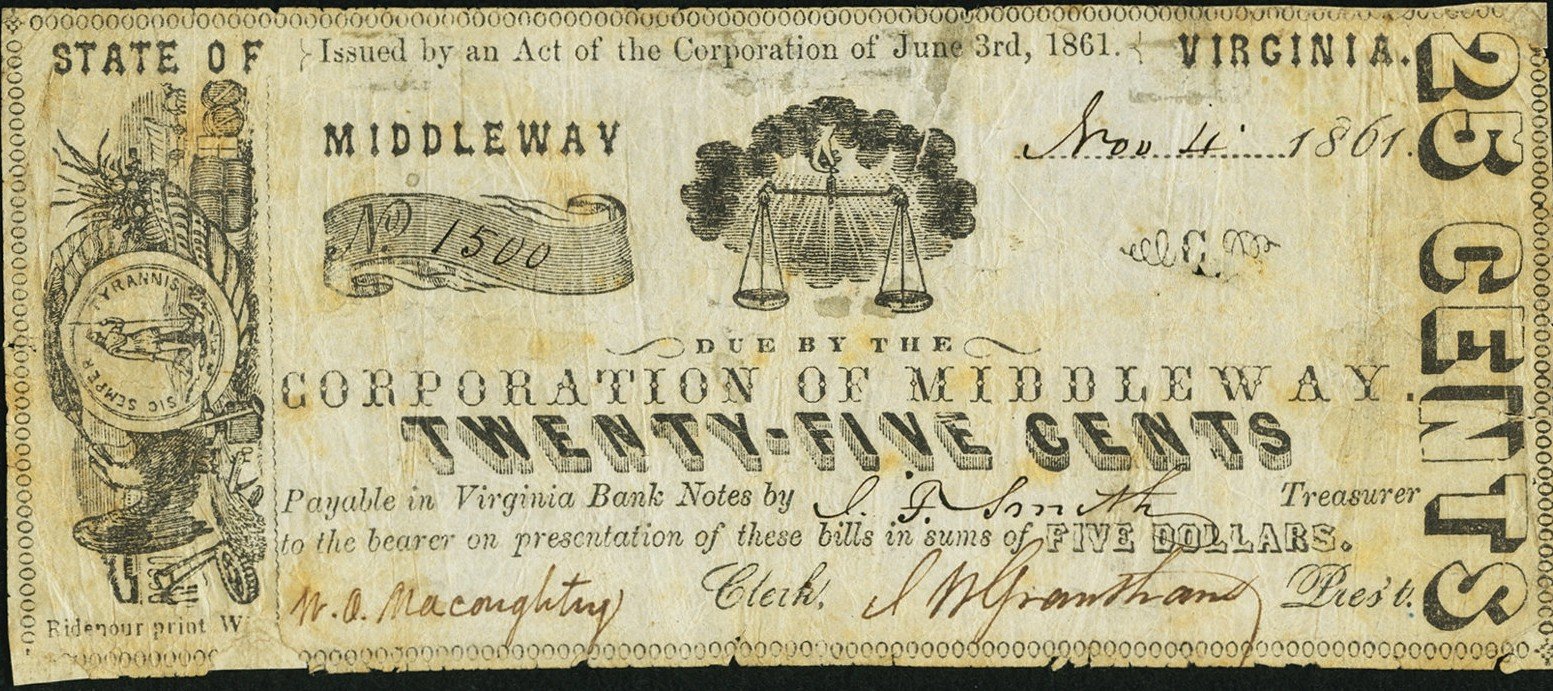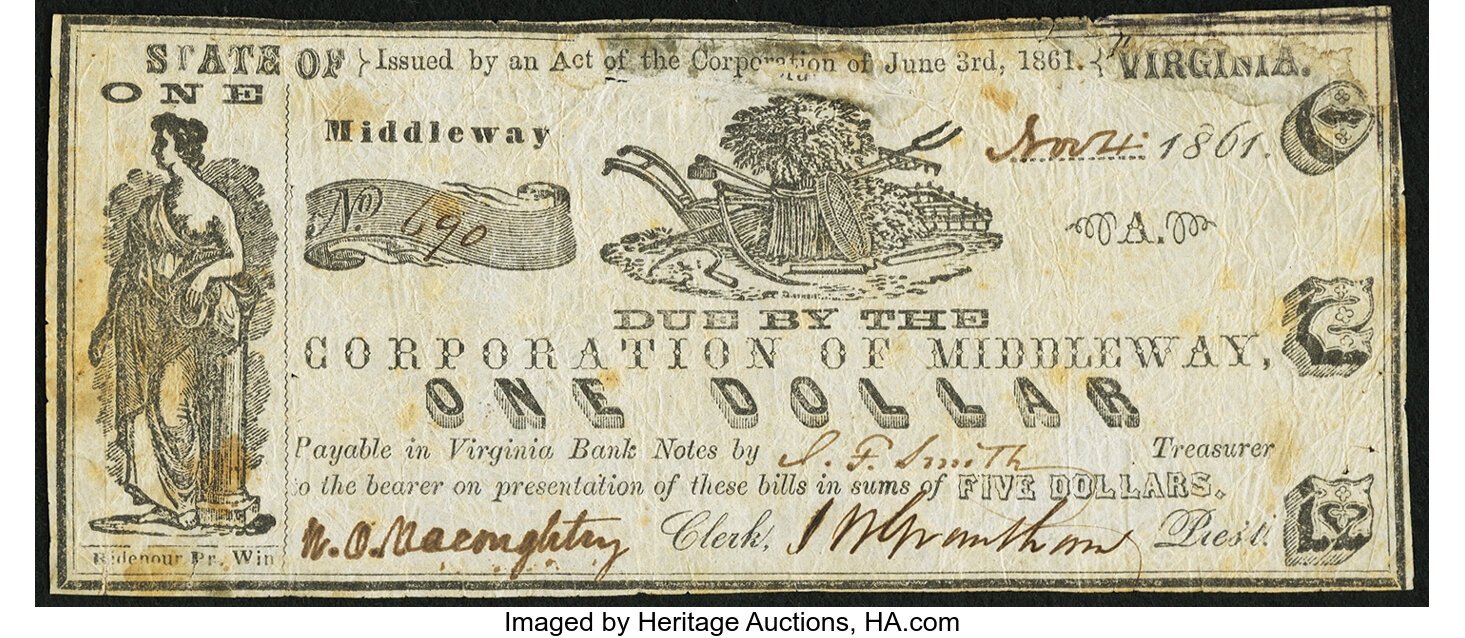
Step back into a colonial, intact pioneer town.
Our History
PAINTING BY LEW PRILLAMAN, FORMER RESIDENT OF MIDDLEWAY
The 25¢ value depicts the scales of Justice being held by a hand in the clouds at center and the Virginia state seal surrounded by an eagle and what could be the Stars and Stripes at left. Estimated number of surviving notes from Middleway pegged at between 5-9 notes., July 4, 1861
Corporation of Middleway Ten Cent Banknote, July 4, 1861
Corporation of Middleway One Dollar Banknote, Nov. 4, 1861
Middleway, mostly unchanged since it’s beginnings, is located at the intersection of two trails used by Native Americans: one trail ran southward from Packhorse Ford (near present day Shepherdstown) and the other ran east and west. Besides the transportation advantages these trails afforded, Turkey Run which comes from a large underground spring which forms Lake Louisa(Louise/Big Spring) about one mile east of the village, provided pure water for the area. Middleway occupies a small part of the original land grant made to Lord Fairfax by the King of England. When John Smith visited the area in 1729, he found these features attractive. By 1734, he and his son together with John's brother, Rees, had established grist and hemp mills along Turkey Run.
By the time of the Revolutionary War, a small farming and milling community had developed. The Smith family had the town surveyed in 1794 and began selling town lots in 1795. The promotion of the village was quite successful, and in 1798 the town of Smithfield was incorporated.
In 1807, a post office under the name of Middleway was established. This name was used to avoid confusion with the other Smithfield in Tidewater, Virginia. This post office was located in various buildings in the village at different times. It operated until 1905, when it was closed due to the inception of Rural Free Delivery.
In the early 1800s, the town was a prosperous regional trading center with a main street lined with shops and houses. According to Charles Varle, in 1810 the town had two churches as well as three well assorted stores, an apothecary shop, one distillery, four shoemakers, five weavers, one wagon maker, one saddle-tree maker, one hatter, three blacksmiths, three tailors, and one tanner; and that there was an attorney at law and a physician.
In the 1830s, when the Baltimore and Ohio Railroad was planning a railroad line from Harpers Ferry to Winchester, many people assumed its path would follow the traditional travel route through Middleway. When the railroad bypassed Middleway, and went through Summit Point instead, the town began a slow process of attrition. However, the commercial decline helped the village retain its early nineteenth century character, as there was little incentive to tear old buildings down and replace them with newer, bigger, more modern ones.
Middleway suffered, along with the rest of the countryside, during the Civil War. For northern armies, Jefferson County was a gateway to the South through the Shenandoah Valley. Middleway was at the intersection of two important roads, and it was located close to major trade centers. Soldiers from both the Union and Confederate armies came through the village throughout the war, and several skirmishes occurred in and around the town. At least four doctors lived in Middleway, and a building, which still stands, served as a hospital. After the battle of Antietam in 1862, wagons brought wounded soldiers to the hospital, straining its capacity of 50 patients.
The largest engagement in the town was the battle of Smithfield in August 1864.
Union losses were placed at 35 killed or wounded, and Confederate losses at 10 killed and 75 wounded. Among the soldiers who died in the fighting were several from North Carolina, who are buried behind the Masonic Hall. Another local reminder of the Civil War is a bullet that is still lodged above the vestry room door of Grace Episcopal Church.
After the war freed slaves established a community, Slabtown, on the southern edge of the village. They built two frame churches and a number of homes there. Although the community no longer exists, the foundations of several buildings can still be seen. A cemetery that served Slabtown also remains.
From the Civil War through the 1880's, times were hard. Many young people left the village to seek better opportunities elsewhere. Stagnation continued for many years and Middleway remained a small country village with many buildings dating from the late 18th and early 19th centuries.
In the middle of the 20th century, a manufacturing plant opened on the outskirts of the village, near the site of John Smith's original mill. It, too, relied on water from Turkey Run for its operations. To accommodate the traffic to the plant, the main road (Queen Street) through Middleway was widened, and many large trees that had lined the smaller road were removed in the process.
In 1980, in recognition of the rare character of the village, the Middleway Historic District was created and added to the National Register of Historic Places.
More information about the history of the village is available in the two-volume book, The Story of Smithfield (Middleway), Jefferson County, West Virginia, by Robert L. Bates. Originally published in 1958, the book has been reprinted and is for sale by the Middleway Conservancy.




